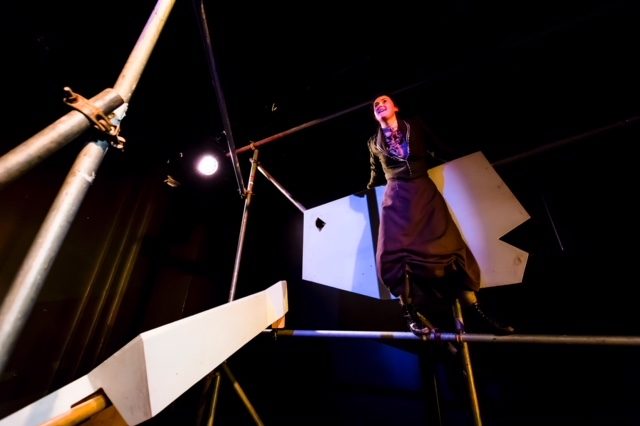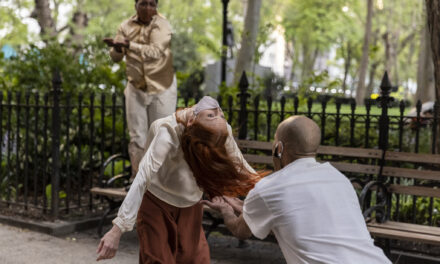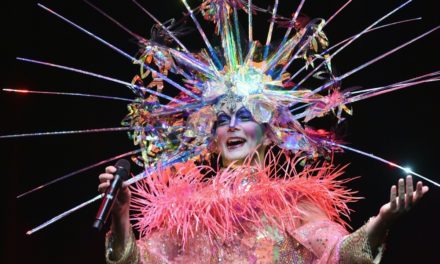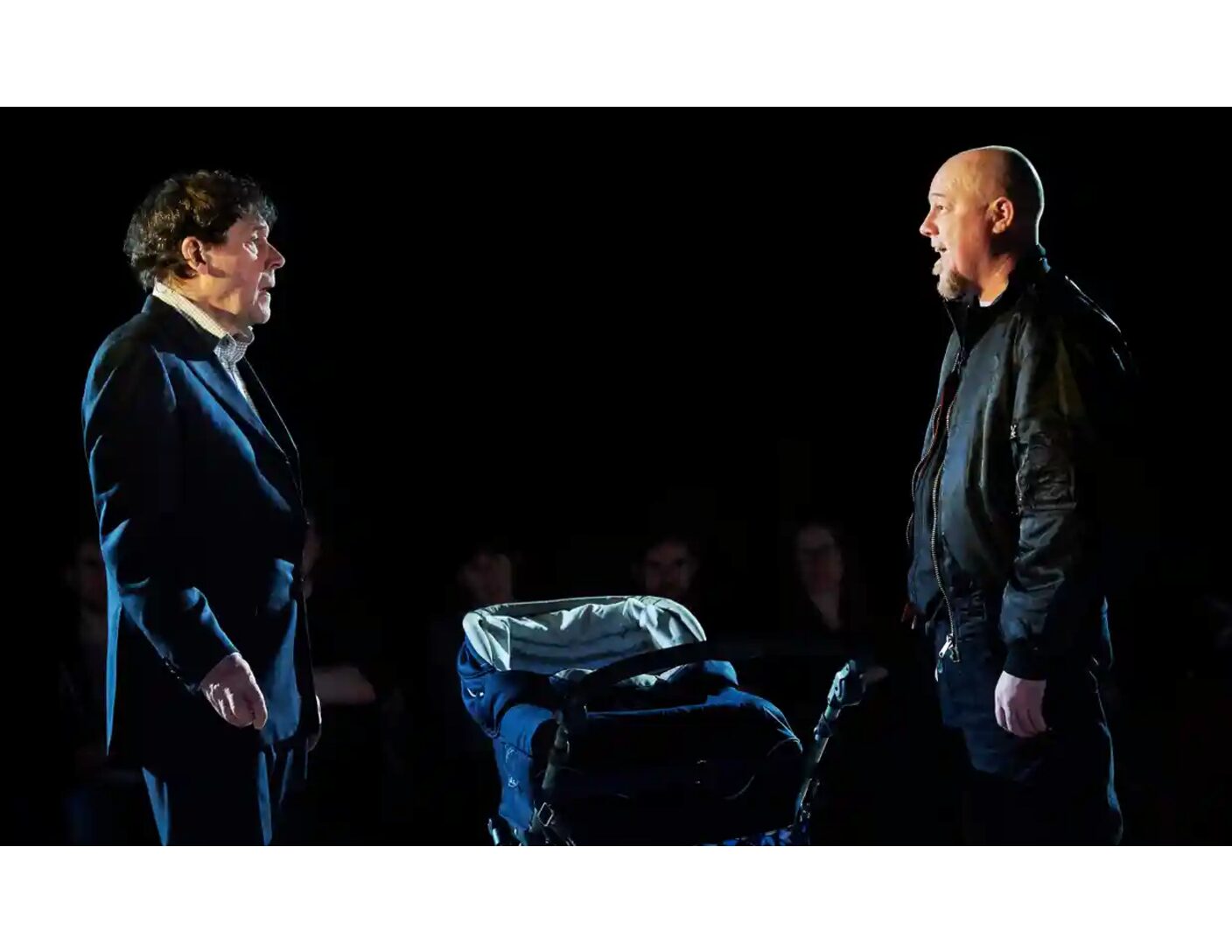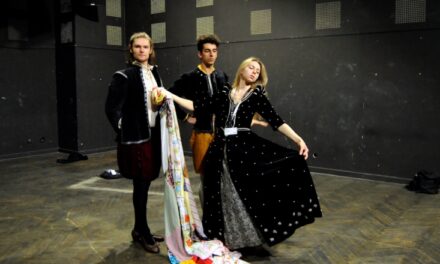
Playwright Jan Bolwell as the older Freda du Faur in Taking the High Ground by Jan Bolwell, directed by Annie Ruth, BATS Theatre, Wellington (2017). Photo credit Philip Merry.
Since Sir Edmund Hillary and Tenzing Norgay became the first to climb Mount Everest in May 1953, New Zealanders have bathed in the reflected glory of their famous mountaineers. The five dollar banknote depicts the craggy, taciturn Hillary contemplating a snowy peak, an iconic New Zealand image that equates rugged independence with masculinity. Jan Bolwell’s new play Taking the High Ground, premiered at BATS Theatre, Wellington on 5 December 2017, re-genders the national mountaineering mythology in feminist terms. Her script conflates the stories of two female mountaineering “firsts” – In 1910, Australian Freda du Faur was the first woman to climb New Zealand’s highest mountain Mount Cook (also known by its Māori name Aoraki), and in 1988 New Zealander Lydia Bradey became the first woman to climb Mount Everest without the assistance of oxygen. As portrayed by Isobel MacKinnon and Emily Regtien respectively, these women are feisty feminist role models.
Bolwell, originally a dancer and choreographer, has built a substantial playwriting CV in recent years with scripts based on historical subject matter. These include Double Portrait (2009) which explores the artistic journey of New Zealand expatriate painter Frances Hodgkins, and Bill Massey’s Tourists (2017) inspired by Bolwell’s grandfather’s experiences as a soldier in World War One. Bolwell often performs in her own plays, and Taking the High Ground is no exception as she plays Freda du Faur at the age of 52 (the significance of this age is revealed later). She provides a still centre to the narrative, the the older Freda interacts with her younger self. The production also features Simon Paenga and Elizabeth Harris, playing a range of smaller roles.
In MacKinnon’s luminous performance, the young Freda blithely brushes aside the sexist expectations of her day, supported by her liberal father. Although Freda develops a close professional relationship with her guide Peter Graham (Paenga) and defies the gender conventions of her day by sharing her tent with two males, the real love of her life is her gym coach Muriel Cadogen with whom she trains in Sydney before they move together to England. The lesbian love story adds another dimension to Freda’s non-conformity. In an impressive double act, Emily Regtien plays both Muriel and Lydia Bradey, enhancing a sense of connection and complicity between women of different generations. In her multi-colored 1980s-style lycra climbing outfit, Lydia takes Freda to task for her impractical Edwardian clothing, but in a delightful moment of theatrical transformation, Freda demonstrates how she ingeniously adapted her skirts, knickerbockers and puttees to make them suitable for rock climbing.
As the play progresses, the joyful celebration of these women’s tenacity becomes tempered by the real story of patriarchal oppression that ended the relationship between Freda and Muriel. The older Freda carries an unspoken psychological burden, which is only revealed later in the play. Muriel’s premature death following shock treatment for what one doctor describes as an “inverted hedonistic persuasion” leads to Freda’s death by her own hand in 1935. The audience realizes that the older Freda has been very close to this final decision throughout the play. Despite Freda’s achievements in pioneering women’s mountaineering, she becomes a victim of patriarchal power that refuses the legitimacy of a lesbian relationship. Taking the High Ground indicts the repressive society that caused such a vibrant and talented woman to take her own life. Late in the play, Freda’s admirers discover her unmarked grave in Manly (Sydney), marking a resurgence of interest in her accomplishments. In contrast, Lydia’s story is more hopeful, as she overcomes attempts to discredit her achievements, and remains a dynamic force in mountaineering. The actual climbing suit that Bradey wore on her first Everest ascent takes pride of place downstage left as a sort of talisman for the production.
The play’s feminist politics are revealed through the overlapping time periods, enabling links to be made between women of different eras. The most striking aspect of the production, however, is the physicality of the two leading performers and the visual imagery. Designer Lisa Maule has created a dynamic scaffolding set composed of intersecting lines and angles, economically suggesting the peaks and crevices of a mountain climb and reflecting the sophisticated dramaturgical layering of the script. The scaffolding is embellished with ice-like white chunks and, in a delightful surrealist gesture, an Edwardian chair. Director Annie Ruth and choreographer Sacha Copland (director of Java Dance Theatre) make the most of the interactive potential of this structure with beautifully choreographed climbing routines. Freda and Lydia perform chin-ups in sync with each other on the scaffolding, a triumphant image of their shared legacy. The set facilitates thrilling theatrical re-enactments of the women’s major climbs, using every inch of the structure to suggest the zig-zagging nature of ascending the highest and most treacherous peaks. When Regtein finally reaches the top of Everest after a harrowing climb, the opening night audience bursts into spontaneous applause. Ultimately, the viscerality and athleticism of these performers make this an uplifting and empowering theatrical experience.
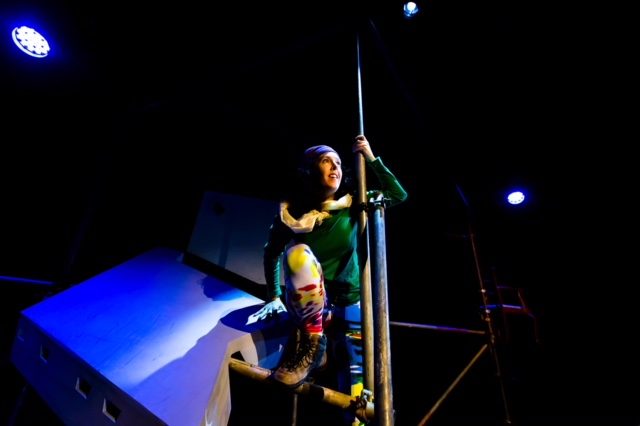
Emily Regtien as Lydia Bradey in Taking the High Ground by Jan Bolwell, directed by Annie Ruth, BATS Theatre, Wellington (2017). Photo credit Philip Merry.
This post was written by the author in their personal capacity.The opinions expressed in this article are the author’s own and do not reflect the view of The Theatre Times, their staff or collaborators.
This post was written by David O'Donnell.
The views expressed here belong to the author and do not necessarily reflect our views and opinions.

